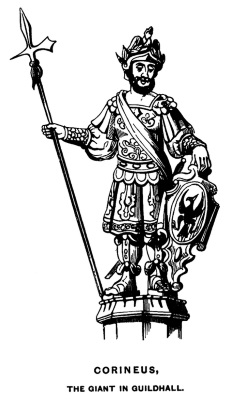
Corineus, in medieval British legend, was a prodigious warrior, a fighter of giants, and the eponymous founder of Cornwall.
According to Geoffrey of Monmouth's History of the Kings of Britain (1136), he led the descendants of the Trojans who fled with Antenor after the Trojan War and settled on the coasts of the Tyrrhenian Sea. After Brutus, a descendant of the Trojan prince Aeneas, had been exiled from Italy and liberated the enslaved Trojans in Greece, he encountered Corineus and his people, who joined him in his travels. In Gaul, Corineus provoked a war with Goffarius Pictus, king of Aquitania, by hunting in his forests without permission, and killed thousands single-handedly with his battle-axe. After defeating Goffarius, the Trojans crossed to the island of Albion, which Brutus renamed Britain after himself. Corineus settled in Cornwall, which was then inhabited by giants. Brutus and his army killed most of them, but their leader, Gogmagog, was kept alive for a wrestling match with Corineus. The fight took place near Plymouth, and Corineus killed him by throwing him over a cliff.